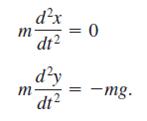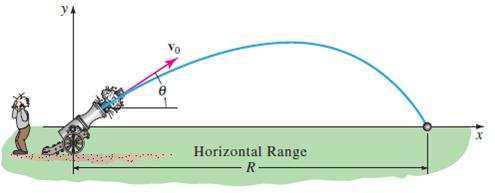(a) A projectile, such as the canon ball shown in Figure 7.R.13, has weight w = mg...
Question:
(a) A projectile, such as the canon ball shown in Figure 7.R.13, has weight w = mg and initial velocity v0 that is tangent to its path of motion. If air resistance and all other forces except its weight are ignored, we saw in Problem 23 of Exercises 4.9 that motion of the projectile is describe by the system of linear differential equations

Use the Laplace transform to solve this system subject to the initial conditions x(0) = 0, x′(0) = v0 cos θ, y(0) = 0, y′(0) = v0 sin θ, where  is constant and is the constant angle of elevation shown in Figure 7.R.13. The solutions x(t) and y(t) are parametric equations of the trajectory of the projectile.
is constant and is the constant angle of elevation shown in Figure 7.R.13. The solutions x(t) and y(t) are parametric equations of the trajectory of the projectile.
(b) Use x(t) in part (a) to eliminate the parameter t in y(t). Use the resulting equation for y to show that the horizontal range R of the projectile is given by

(c) From the formula in part (b), we see that R is a maximum when sin 2θ = 1 or when θ = π/4. Show that the same range—less than the maximum—can be attained by firing the gun at either of two complementary angles θ and π/2 – θ The only difference is that the smaller angle results in a low trajectory whereas the larger angle gives a high trajectory.
(d) Suppose g = 32 ft /s2, θ = 38°, and v0 = 300 ft/s. Use part (b) to find the horizontal range of the projectile. Find the time when the projectile hits the ground.
(e) Use the parametric equations x(t) and y(t) in part (a) along with the numerical data in part (d) to plot the ballistic curve of the projectile. Repeat with θ = 52° and v0 = 300ft/s Superimpose both curves on the same coordinate system.

Step by Step Answer:

A First Course in Differential Equations with Modeling Applications
ISBN: 978-1111827052
10th edition
Authors: Dennis G. Zill





